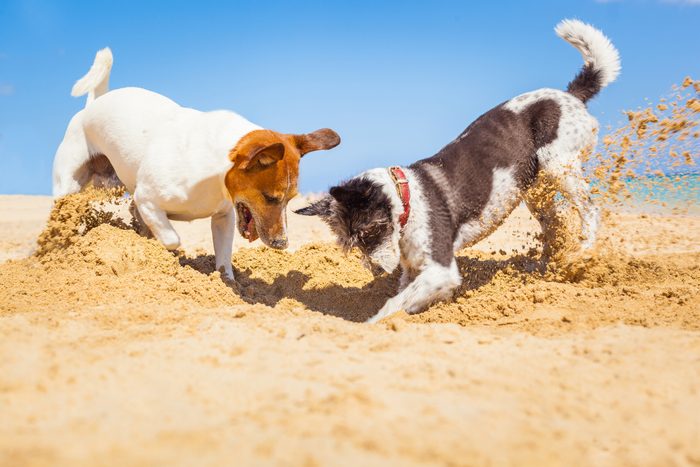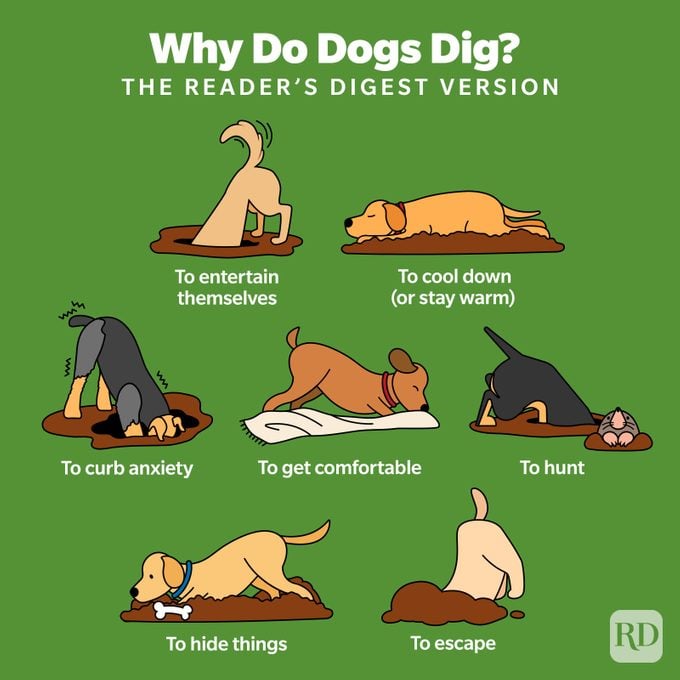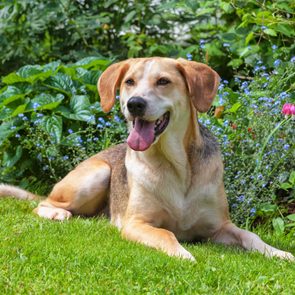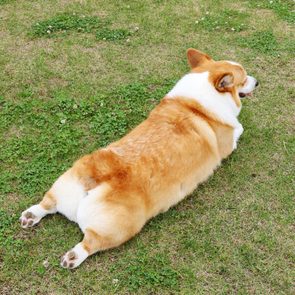Why Do Dogs Dig—and How Can You Stop It?
Updated: Aug. 15, 2023

Your dog isn't creating craters in your yard to be contrary. Find out why dogs dig, and use these expert tips to curb the messy habit.
Some dog behaviors that might seem quirky to us are often instinctual. A pooch kicking up the lawn after they pee is usually marking their territory. And a mucky pup eating dirt could be because they’re bored, curious or anxious. Digging is another instinctual behavior for dogs, but you may be wondering: Why do dogs dig?
It’s pretty cute when your feisty fido excavates sand on your beach stroll, but not so much when they make potholes on your lush lawn, trail mud through your clean kitchen or scrabble on your sofa enough to leave scratch marks. Plus, determined diggers can land themselves in trouble if they create a yard escape route or unearth poisonous plant bulbs.
We asked an expert about why dogs tend to dig—and what savvy strategies might keep you from patching up your grass every week. You already know how to train a dog and how to train a puppy. But it’s not always about the training when it comes to digging. Offering alternative outlets and addressing your dog’s needs can curb inappropriate digging while satisfying their bug to burrow.
Get Reader’s Digest’s Read Up newsletter for pets, humor, cleaning, travel, tech and fun facts all week long.

Why do dogs dig?
While it might be a habit that’s driving you to distraction, for some dogs, digging comes as naturally as barking or sniffing. It’s rare for dogs to dig for no reason. So rather than concentrating on stopping your dog from digging, it’s better to ask yourself why do dogs dig holes? Getting to the root of it will help you tackle the problem and keep your hound happy. Here are some common reasons behind dog digging.
It’s fun, and they are bored
One of the main reasons dogs dig is because it’s fun, and if your dog is bored, it’s a great way to stay entertained. Certified dog trainer Maddie Messina says this is a common habit when you aren’t meeting your dog’s natural mental and physical requirements. She recommends keeping your dog busy and offering other enrichment. Some activities Messina suggests include long, sniffy walks outdoors; body conditioning skills, such as sit, stand or push up; dog tricks; shredding paper; playing with a flirt pole; and practicing nose work, which gives your dog challenges to locate specific scents.
To hunt
“Many dogs, like terriers and smaller hounds, were bred to hunt small animals,” Messina says. This hard-wired drive and a sophisticated sense of smell means it can be hard for them to resist the urge to dig. Especially if a mole, gopher or groundhog creates an underground den in your yard. Getting rid of rodents with humane, pet-safe strategies can help douse your dog’s desire to dig.
To cool down (or stay warm)
“Many dogs will dig to unearth a cooler resting spot,” Messina says. You’re more likely to see this in the Nordic breeds, such as Siberian huskies, as they naturally use ground dens to keep cool in the summer and warm in the winter. If your dog only digs on a hot day, it’s a sign that you need to help them stay cool. Dogs can’t regulate their temperature as easily as people, and dog heatstroke is no joke. Some summer safety tips include:
- Offering lots of shady spots
- Introducing a pet-safe paddling pool
- Using dog cooling vests or cooling beds
- Keeping your dog indoors on scorching hot days or when the temperature plummets
Because of anxiety
“I have noticed anecdotally that my dog digs as a displacement behavior,” Messina says. “He is prone to doing this in new environments and especially in new cars when he’s having a hard time calming himself.” If your dog is sound-sensitive and your yard is near a busy road, or they hate being left, they might dig to relieve stress.
Watch your dog’s body language. Signs of dog anxiety include a tucked tail, flattened ears, excessive panting, shaking, drooling, scratching or subtle movements, such as lip-licking or yawning.
Sometimes, it’s obvious what’s making your dog anxious and you can remove the triggers to keep them happy. If you’re unsure what’s causing your dog’s anxiety or how to tackle it, contact a certified behaviorist. They can provide tools and tips to identify triggers and help your dog feel more relaxed around them.
To get comfy
Messina says another reason dogs dig is to help them settle down for a nap. “I think they are just using their paws to manipulate their resting spot and make it as comfortable as possible,” she says.
This denning behavior might seem cute at first, but if you have a new sofa, you probably don’t want it to end up torn or tattered. If you don’t want to cast your dog off the couch permanently, you can cover it with a secure doggy blanket. “I’ve been working on rewarding my dog for getting on the couch and laying down without any digging,” Messina says.
To escape
Your frisky fido might dig under the yard fence to reach friends, the local snack bar or, in the case of unneutered males, a favorite lady dog. Once your dog is rewarded with nice things on the other side, they’ll want to keep doing it. Dogs that have separation anxiety or are fearful in the yard might also try to find an escape route.
This is one reason for digging you don’t want to delay dealing with. The best strategy is to not leave your dog unsupervised in the yard. But if they are a hairy Houdini that makes a bid for freedom every time you turn your back, you might need to reinforce the base of your fence.
To hide things
Dogs like to bury bones. So if you can’t find the juicy one you gave your dog 15 minutes ago, there’s a good chance they’ve dug a hole for this high-value item. That way, they can keep it safe until they’re ready to return to it. Only offer these prized possessions when you’re around to supervise.
Should you let your dog dig?
Studies show that redirecting and rewarding a dog for digging in a designated digging spot is a savvy strategy. Your dog can still partake in a behavior that makes them happy while reducing the chance of them digging up your lawn or damaging your sofa.
“If you have yard access, this could be a sandpit,” Messina says. “If you don’t, I’m a fan of using a lightweight kiddie pool or even a flexible pen to build an indoor digging pit with scraps of old fabric and toys.” If your dog isn’t digging it at first, Messina suggests encouraging them by burying some treats.
“I would even go as far as to reinforce the dog every time I see them digging in their new legal digging spot,” she says.
How to train your dog not to dig
If you don’t address the reason behind the behavior, it will be tricky to train your dog not to dig. Offering an alternative digging outlet, ensuring your dog is getting enough exercise and enrichment, and putting suitable management strategies, like the ones below, in place will best set you up for success. Here are some other tips.
- Don’t leave your dog in the yard unsupervised.
- Reinforce your fence.
- Set up a gate or pen to keep your dog out of the area they are digging up.
- Make the spots you don’t want your dog to dig up unattractive.
Messina says you can also teach your dog a positive interruption cue. “This is a cue that gets your dog to stop what they are doing and look at you,” she says. Always reward them for stopping the unwanted behavior by offering a tasty treat or favorite toy.
What not to do when training your dog not to dig
Set your dog up for success by avoiding these techniques when trying to quash inappropriate digging.
- Don’t punish your dog. “The digging won’t go away if you punish your dog,” Messina says. “They will just become sneakier about when and where they dig.” Punishing your dog can also damage your bond and make a dog that’s digging because of anxiety even more fearful.
- Don’t use deterrents. Sprinkling things like cayenne pepper means your dog will likely move their digging to a new spot, and ingesting it isn’t pleasant and can build a negative association with the yard. Plus, reapplying it after every rain shower isn’t a good long-term strategy.
- Don’t leave your dog tied up. It’s not safe or fair to tether your dog unsupervised for long periods.
About the expert
- Maddie Messina, MA, CPDT-KA, is a certified dog trainer and applied animal behaviorist. She owns Paws for Thought dog training in New York City and has a master’s degree in animal behavior and conservation.
Sources:
- Animals: “Challenges and solutions surrounding environmental enrichment for dogs and cats”






















